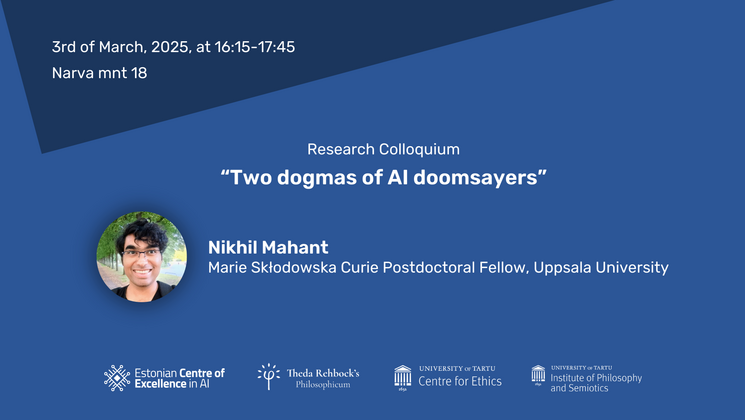-
Faculty of Arts and HumanitiesDean's Office, Faculty of Arts and HumanitiesJakobi 2 ruumid 116–121, 51005 Tartu linn, EST0Institute of History and ArchaeologyJakobi 2 51005 Tartu linn, Tartu linn, Tartumaa EST0Institute of Estonian and General LinguisticsJakobi 2, IV korrus 51005 Tartu linn, Tartu linn, Tartumaa EST0Institute of Philosophy and SemioticsJakobi 2, III korrus, ruumid 302-337 51005 Tartu linn, Tartu linn, Tartumaa EST0Institute of Cultural ResearchÜlikooli 16 51003 Tartu linn, Tartu linn, Tartumaa EST0Institute of Foreign Languages and CulturesLossi 3 51003 Tartu linn, Tartu linn, Tartumaa EST0School of Theology and Religious StudiesÜlikooli 18 50090 Tartu linn, Tartu linn, Tartumaa EST0Viljandi Culture AcademyPosti 1 71004 Viljandi linn, Viljandimaa EST0Professors emeriti, Faculty of Arts and Humanities0Associate Professors emeriti, Faculty of Arts and Humanities0Faculty of Social SciencesDean's Office, Faculty of Social SciencesLossi 36 51003 Tartu linn, Tartu linn, Tartumaa EST0Institute of EducationJakobi 5 51005 Tartu linn, Tartu linn, Tartumaa EST0Johan Skytte Institute of Political StudiesLossi 36, ruum 301 51003 Tartu linn, Tartu linn, Tartumaa EST0School of Economics and Business AdministrationNarva mnt 18 51009 Tartu linn, Tartu linn, Tartumaa EST0Institute of PsychologyNäituse 2 50409 Tartu linn, Tartu linn, Tartumaa EST0School of LawNäituse 20 - 324 50409 Tartu linn, Tartu linn, Tartumaa EST0Institute of Social StudiesLossi 36 51003 Tartu linn, Tartu linn, Tartumaa EST0Narva CollegeRaekoja plats 2 20307 Narva linn, Ida-Virumaa EST0Pärnu CollegeRingi 35 80012 Pärnu linn, Pärnu linn, Pärnumaa EST0Professors emeriti, Faculty of Social Sciences0Associate Professors emeriti, Faculty of Social Sciences0Faculty of MedicineDean's Office, Faculty of MedicineRavila 19 50411 Tartu linn, Tartu linn, Tartumaa ESTInstitute of Biomedicine and Translational MedicineBiomeedikum, Ravila 19 50411 Tartu linn, Tartu linn, Tartumaa ESTInstitute of PharmacyNooruse 1 50411 Tartu linn, Tartu linn, Tartumaa ESTInstitute of DentistryL. Puusepa 1a 50406 Tartu linn, Tartu linn, Tartumaa ESTInstitute of Clinical MedicineL. Puusepa 8 50406 Tartu linn, Tartu linn, Tartumaa ESTInstitute of Family Medicine and Public HealthRavila 19 50411 Tartu linn, Tartu linn, Tartumaa ESTInstitute of Sport Sciences and PhysiotherapyUjula 4 51008 Tartu linn, Tartu linn, Tartumaa ESTProfessors emeriti, Faculty of Medicine0Associate Professors emeriti, Faculty of Medicine0Faculty of Science and TechnologyDean's Office, Faculty of Science and TechnologyVanemuise 46 - 208 51003 Tartu linn, Tartu linn, Tartumaa ESTInstitute of Computer ScienceNarva mnt 18 51009 Tartu linn, Tartu linn, Tartumaa ESTInstitute of GenomicsRiia 23b/2 51010 Tartu linn, Tartu linn, Tartumaa ESTEstonian Marine Institute0Institute of PhysicsInstitute of ChemistryRavila 14a 50411 Tartu linn, Tartu linn, Tartumaa EST0Institute of Mathematics and StatisticsNarva mnt 18 51009 Tartu linn, Tartu linn, Tartumaa EST0Institute of Molecular and Cell BiologyRiia 23, 23b - 134 51010 Tartu linn, Tartu linn, Tartumaa ESTTartu ObservatoryObservatooriumi 1 61602 Tõravere alevik, Nõo vald, Tartumaa EST0Institute of TechnologyNooruse 1 50411 Tartu linn, Tartu linn, Tartumaa ESTInstitute of Ecology and Earth SciencesJ. Liivi tn 2 50409 Tartu linn, Tartu linn, Tartumaa ESTProfessors emeriti, Faculty of Science and Technology0Associate Professors emeriti, Faculty of Science and Technology0Institute of BioengineeringArea of Academic SecretaryHuman Resources OfficeUppsala 6, Lossi 36 51003 Tartu linn, Tartu linn, Tartumaa EST0Area of Head of FinanceFinance Office0Area of Director of AdministrationInformation Technology Office0Administrative OfficeÜlikooli 17 (III korrus) 51005 Tartu linn, Tartu linn, Tartumaa EST0Estates Office0Marketing and Communication OfficeÜlikooli 18, ruumid 102, 104, 209, 210 50090 Tartu linn, Tartu linn, Tartumaa EST0Area of RectorRector's Strategy OfficeInternal Audit OfficeArea of Vice Rector for Academic AffairsOffice of Academic AffairsUniversity of Tartu Youth AcademyUppsala 10 51003 Tartu linn, Tartu linn, Tartumaa EST0Student Union OfficeÜlikooli 18b 51005 Tartu linn, Tartu linn, Tartumaa EST0Centre for Learning and TeachingArea of Vice Rector for ResearchUniversity of Tartu LibraryW. Struve 1 50091 Tartu linn, Tartu linn, Tartumaa EST0Grant OfficeArea of Vice Rector for DevelopmentCentre for Entrepreneurship and InnovationNarva mnt 18 51009 Tartu linn, Tartu linn, Tartumaa EST0University of Tartu Natural History Museum and Botanical GardenVanemuise 46 51003 Tartu linn, Tartu linn, Tartumaa EST0International Cooperation and Protocol Office0University of Tartu MuseumLossi 25 51003 Tartu linn, Tartu linn, Tartumaa EST0
Research news: financial well-being, dialect training for computers, vitamin D, and parasitic helminths

Social Sciences
People’s evaluation of their financial well-being is influenced by both age and the global consumer culture
Data collected in sixteen countries showed that it is wrong to assume that people in wealthier countries have greater financial well-being. The study analysed how age, gender, income and education are associated with current money management stress and expected future financial security. People’s evaluation of their ability to maintain current living standards or reach a desired lifestyle in the future is influenced by both individual and contextual factors.
As expected, the size of income plays a significant role in financial well-being. Comparisons between countries show that differences between age groups can be more significant than between countries. Comparisons with people of similar lifestyles can have at least as much impact on the evaluations of financial well-being as comparisons with peers living in the same city. Thus, global consumer culture may better explain the differences in financial well-being evaluations than national borders and economic indicators.
However, access to financial services and trust in the government affect the level of stress arising from people’s financial management. The respondents’ stress level is lower when trust in the government is high and services are accessible. Cultural background is the factor that best explains the future financial well-being estimates. Individualistic people are more pessimistic about their future than representatives of more collectivistic cultures. For example, the study showed that the score of future financial security is the highest in the Philippines.
Read more in the article published in the Journal of International Marketing.
Further information: Leonore Riitsalu, Research Fellow in Behavioural Policy, leonore.riitsalu@ut.ee
Arts and Humanities
Finnish dialect generator helps computers also learn Estonian dialect
The digital resources of standard Estonian are quite good: we have a relatively rich language corpus to train machine learning models and develop digital translation and language learning programs. However, the situation with Estonian dialects is different due to the shortage of materials suitable for training machine learning models. To overcome this problem, researchers used the dialect generator created for the Finnish language to synthetically “dialectalise” the texts in the Estonian corpus. The experiment aimed to create dialectal resources that could be used to train a machine learning model that understands the Estonian dialect.
The experiment results showed that, although the word error rate of the program was somewhat higher than with standard Estonian, the synthetic dialectal sentences created on the basis of Finnish dialect can help develop machine learning for Estonian dialects.
The study conducted by researchers of École Normale Superieure of Paris and the University of Tartu was presented at the international conference DeepLo 2022. An article introducing the study was published in the Proceedings of the DeepLo Workshop.
Further information: Tuuli Tuisk, Research Fellow in Phonetics of Finnic Languages, University of Tartu, tuuli.tuisk@ut.ee
Medicine
The daily intake needs to increase to maintain the required level of vitamin D
University of Tartu researchers conducted a study in the Estonian Defence Forces to monitor changes in the vitamin D levels in conscripts’ bodies at recommended daily doses. The sample was divided into an intervention group of 27 conscripts and a placebo group of 26 conscripts. From October 2016 to April 2017, i.e. for seven consecutive months, once a day, the intervention group received vitamin D3 capsules of 1200 units (IU) and the placebo group received olive oil capsules.
At the end of the experiment, the conscripts’ vitamin D level was measured again. According to scientific literature, if vitamin D content in blood is below 75 nmol/l, it is defined as vitamin D deficiency. By March, the vitamin D level of 65% of the placebo group members and 15% of the intervention group members was critically low, i.e. below 25 nmol/l. No other blood tests revealed any significant differences at any point of time. According to the researchers, the study confirms that in order to avoid vitamin D deficiency and keep healthy, it is necessary to increase the daily dose of vitamin D to more than 1200 units.
Read further from the article published in the Journal of the International Society of Sports Nutrition.
Further information: Leho Rips, doctoral student of Medicine, leho.rips@ut.ee
Science and Technology
Widespread transmission of parasitic helminths from wild animals to dogs could pose a significant health risk to humans
University of Tartu scientists investigated the prevalence of parasitic helminths in West-Estonian predators and their transmission to domestic dogs roaming freely in the area. To this end, they collected scat samples of predators from the area and applied genetic methodology to identify the exact predator species from the scat. The data were compared with those collected from dogs in the same area in a previous study. Almost 90% of red foxes and golden jackals were found to have helminths. Parasites of the same type were also predominant in domestic dogs in the area. Comparing the data with the parasitological studies among humans in Estonia, it appears that the transmission of pathogens from predators to dogs and from dogs to humans can make the parasitic infections of wild animals a critical human health problem.
Read more in the article published in the journal Parasitology.
Further information: Ants Tull, Junior Research Fellow of Parasitology, ants.tull@ut.ee
Read more similar news





